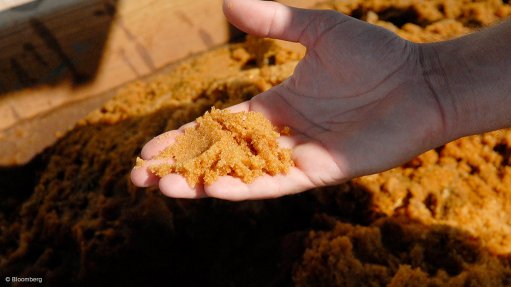
Photo by: Bloomberg
VANCOUVER (miningweekly.com) – Despite lacklustre uranium spot and contract prices, Canadian producer Cameco announced on Thursday that its joint venture (JV) over the Inkai in situ recovery uranium mine, in south Kazakhstan, with the National Atomic Company of the Republic of Kazakhstan (Kazatomprom), will lift output by 25% this year over 2017.
The miner revealed the production forecast in a new National Instrument 43-101-compliant technical report filed with security regulators on Thursday, saying JV Inkai produced 5.5-million pounds of uranium oxide (U3O8) in 2017, of which Cameco's share was 3.2-million pounds.
During 2018, forecast output for the operations is 6.9-million pounds U3O8, of which 3.4-million pounds is attributable to Cameco.
Under a restructured ownership that was effective from January 1, Kazatomprom's share in Inkai increased from 40% to 60% and will see Kazatomprom gain operational control of the mine, while Cameco's share shrunk to 40%.
The production increase stands in stark contrast to significant production cuts announced separately by the partners last year, in efforts to bring the vastly oversupplied market closer to balance, or deficit. However, the operation's low-cost structure will ensure profitability, even at the current low uranium prices.
Uranium prices have fallen by more than 70% since the Fukushima accident in March 2011 and remain at unsustainably low levels. Long-term contract pricing has fallen to the lowest price since June 1, 2005, at $30/lb of yellow cake, with spot prices hovering at the $20/lb level.
Cameco will suspend production for ten months at McArthur River, Saskatchewan – the world's biggest uranium mine – and the nearby Key Lake mill by the end of January, because of low prices. Early in December, Kazatomprom's announcement that it would curtail another 20% of output for three years, starting from January, sent most TSX-listed uranium companies' equities soaring.
The decision will see Kazatomprom defer production of about 11 000 t of uranium over the period, of which about 4 000 t in 2018 represents about 7.5% of global output. Kazatomprom accounts for about 21% of global output, but it mostly sells into the spot market, which has been crawling sideways for several quarters now.
Cameco currently relies almost exclusively on the Cigar Lake mine, in Saskatchewan, and the Inkai mine to produce significant volumes. Major producer Orano also announced production cuts in Niger.
According to Cameco, JV Inkai has the right to lift output to 10.4-million pounds of U3O8 a year, subject to market conditions and the terms of the resource use contract, with a projected mine life extending to mid-2045.
The report also outlines that forecast output is estimated at 229.2-million pounds U3O8 over the remaining mine life, of which 92.6-million pounds are attributable to Cameco; cash operating costs are estimated to be C$9.55/lb of U3O8; and capital costs are estimated to be C$1.06-billion on a 100% basis.
Cameco plans to publish its 2017 annual results, 2017 production and 2018 plans on February 9.